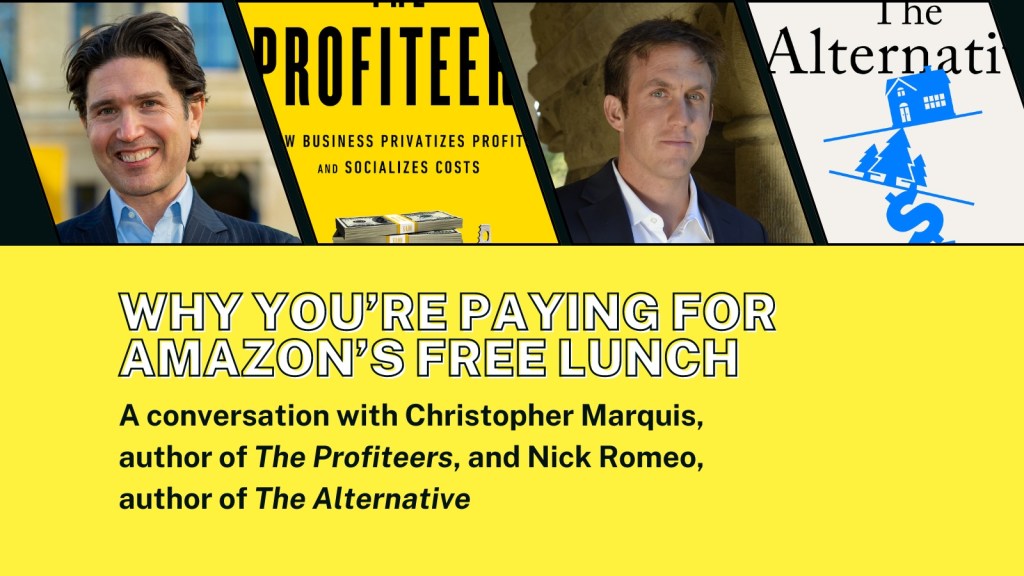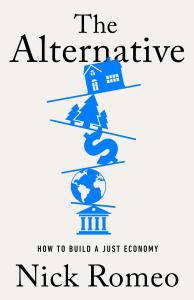Why You’re Paying for Amazon’s Free Lunch: A conversation with Christopher Marquis and Nick Romeo

In 2019, Amazon announced the Climate Pledge, a commitment to reach net-zero carbon by 2040, ten years ahead of the UN Paris Agreement goal. Since then, the retailing juggernaut, which now has about 1.5 million employees, has claimed to have made huge strides toward this goal. But there’s a big catch: the company only accounts for the climate impacts of products with its brand label — which make up just 1% of its online sales.
Meanwhile, the company pays very little in taxes. In 2021, Amazon reported record profits of more than $35 billion but paid just 6% in federal corporate income taxes in the United States. In 2021 and 2022, it paid no corporation tax at all in the United Kingdom.
This is the perfect example of how corporations push the cost of their success onto society, says Christopher Marquis, the Sinyi Professor at the University of Cambridge Judge School of Business. In his latest book, The Profiteers: How Business Privatizes Profits and Socializes Costs, Marquis argues that Amazon is hardly the only corporation making you, the taxpayer, foot the bill for their stunning profits.
In full agreement with Marquis is Nick Romeo, who covers policy and ideas for The New Yorker and teaches in the Graduate School of Journalism at the University of California, Berkeley. His latest book is The Alternative: How to Build a Just Economy.
In the conversation below, which has been edited for clarity and length, the two authors discuss the importance of externalities, alternative ways of thinking about social costs, and why ideas like “personal carbon footprint” are misguided.
PublicAffairs: Chris, your book is all about how companies avoid paying for externalities and instead make us pay for them instead. To start, what is an externality?
Chris Marquis: So an externality is basically a cost of production that is not born by the producer. Pollution is a famous example. Companies aren’t charged for pollution, which spreads everywhere and impacts people’s health and the environment. One of the reasons I wrote my book is that economics and accounting typically see externalities as neutral market imperfections. But actually, companies are strategic about avoiding them and actively work to push these costs off of their income statement through a variety of strategies.
PA: Nick, in your book you have a chapter on True Price, which is one way that researchers are trying to make invisible externalities more visible. Can you tell us more about that effort?
Nick Romeo: So True Price connects directly to what Chris was saying about externalities. If the environmental and social costs are internalized, so to speak, a lot of goods wouldn’t be so cheap. But, there’s still a question about who ought to foot the bill. One solution would be a consumer-facing model. Another would be the companies themselves. A third might involve some kind of policy or regulatory compromise, where taxes and subsidies at least alleviate some of these external costs.
CM: To piggyback on what Nick was saying, I’m a big fan of True Price and also profile their work in The Profiteers. But, I think that maybe “true cost” is a better way to think about it because “price” makes it seem like consumers should be the ones responsible. A lot of what companies have done is to try to shift the thinking of who should pay for things to consumers, like BP convincing us all that we should have to think about our carbon footprint instead of taking responsibility for emission themselves, or companies promoting plastic recycling, which doesn’t work, instead of actually fixing their packaging system. I do think we all should recycle, but we need larger policies as well that hold companies accountable for the societal and environmental damage they create.
PA: I absolutely agree. Like Chris said, this is not synonymous with saying individual choice doesn’t matter. It’s just a kind of realism about the different levels at which intervention is possible and the enormous power that companies have to intervene in their own supply chains. It’s not really parallel to what one person at the grocery store can do.
CM: To add a little bit on the policy side, I do think in the EU there’s increasing momentum here because now we’re seeing laws that actually have legal bite. The last year or two, they have introduced a green claims law, where companies can basically be sued for greenwashing, and new ESG accountability laws that are quite rigorous. As these regulations start ramping up, companies won’t be so able to push these problems further down or up their supply chain.
PA: Chris, you mention a number of tactics that companies use to deflect and confuse the public, like gaslighting, astroturfing, and greenwashing. What are some ways that we, as consumers, can be more literate when it comes to these kinds of messaging?
CM: I think it’s good to be skeptical, especially of voluntary actions. Third-party certifications provide a little bit of leverage, although those have been greenwashed as well, like organic cotton, where there’s been a lot of abuse in the system. Another area that I’ve studied is B Corporations, which are companies that have undergone a detailed audit of their social and environmental performance. If I were a consumer and wanted to make a difference, purchasing from better companies is part of it. However, working in state houses and legislatures is where the change is needed. If we’re going to actually shift corporate behavior, the floor in regulation and law needs to be raised.
NR: Absolutely. It’s hard to overstate the risk of false signaling and free riding by companies. And it’s a bit insidious because you do have some companies actually doing good things in a number of categories. And yet, it’s quite difficult for them to convey a trustworthy signal to investors or consumers precisely because of this kind of pollution of the information environment. There’s so much hype, and advertising is so well funded that it can be hard for the people behaving well to get recognized.
PA: Chris, in the book you return often to a carpet company called Interface. Why are they a good model for how businesses can make substantive changes?
CM: In the 1990s, Interface’s founder, Ray Anderson, had this epiphany that the way he was running his business was immoral. They used a lot of glues and polyester and nylon components, which are pretty environmentally damaging materials, and they ship heavy things far away. So Anderson realized that the core of his business was destructive and initiated a multi-decade odyssey to reverse the company’s environmental impact from negative to positive.
Innovation in new greener materials was part of the solution, but what really interests me is how making this commitment resulted in them rethinking their business model..One thing they did was switch to installing their carpet in squares, which is much more sustainable because you can just replace squares here and there. They also made their business a service as opposed to something you sell. So customers functionally lease the carpet from Interface, which puts the onus on the company to think about what to do with the carpet at the end of its life. It shows a cognitive shift away from the traditional way to actually thinking in a more circular, regenerative way.
In an age when business leaders solemnly profess dedication to principles of environmental and social justice, Christopher Marquis’s provocative investigation into the real costs of doing business reveals the way that leaders of the corporate world gaslight to evade responsibilities by privatizing profits and socializing costs. “Who pays?” for the resulting climate and environmental damage, racism, low wages, and cheap goods: the average citizen and the taxpayer.
By bringing to light ideas that today are on the fringe but rapidly making their way into the mainstream, Marquis outlines a new regenerative paradigm for business in society. He tells of a group of pioneers trying to not just reform but transform the way business is conducted all over the world. By taking novel actions to reimagine business operations in responsible ways, minimize their negative impacts, and create new ways for business to properly absorb their hidden costs, these leaders provide blueprints to move the needle on vexing social and environmental issues.
What’s in it for leaders of the corporate world? The model of reform presented provides clear guidance on how to get ahead of the curve as an emerging economic order is formed. No business can lead from the front if it is morally-backward looking. History has shown time and again that those who get out in front of emerging changes in our social and environmental landscape protect themselves from inevitable eclipse.
Confronted by the terrifying trends of the early twenty-first century – widening inequality, environmental destruction, and the immiseration of millions of workers around the world – many economists and business leaders still preach dogmas that lack evidence and create political catastrophe: Private markets are always more efficient than public ones; investment capital flows efficiently to necessary projects; massive inequality is the unavoidable side effect of economic growth; people are selfish and will only behave well with the right incentives.
But a growing number of people – academic economists, business owners, policy entrepreneurs, and ordinary people – are rejecting these myths and reshaping economies around the world to reflect ethical and social values. Though they differ in approach, all share a vision of the economy as a place of moral action and accountability. Journalist Nick Romeo has spent years covering the world’s most innovative economic and policy ideas for The New Yorker. Romeo takes us on an extraordinary journey through the unforgettable stories and successes of people working to build economies that are more equal, just, and livable. Combining original, in-depth reporting with expert analysis, Romeo explores:
- The successful business owners organizing their companies as purpose trusts (as Patagonia recently did) to fulfill a higher mission, such as sharing profits with workers or protecting the environment
- The growing deployment of new models by venture capital funds to promote wealth creation for the poorest Americans and address climate change.
- How Oslo’s climate budgeting program is achieving the emission reduction targets the rest of the world continues to miss, creating a model that will soon be emulated by governments around the world
- How Portugal strengths democratic culture by letting citizens make crucial budget decisions
- The way worker ownership and cooperatives foster innovation, share wealth, and improve the quality of jobs, offering an increasingly popular model superior to the traditional corporation
- The public-sector marketplace that offers decent work and real protections to gig workers in California
- The job guarantee program in southern Austria that offers high-quality meaningful jobs to every citizen

